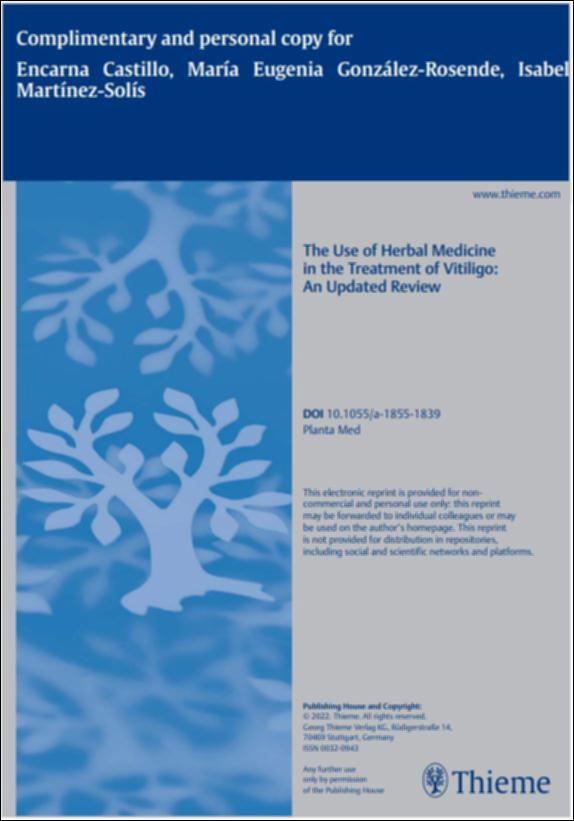Please use this identifier to cite or link to this item:
http://hdl.handle.net/10637/15012The use of herbal medicine in the treatment of vitiligo: an updated review

See/Open:
Use_Castillo_PM_2023.JPG
57,45 kB
JPEG
See/Open:
Use_Castillo_PM_2023.pdf
Restricted Access
436,14 kB
Adobe PDF
Request a copy
| Title: | The use of herbal medicine in the treatment of vitiligo: an updated review |
| Authors : | Castillo García, Encarnación González Rosende, María Eugenia Martínez Solís, Isabel |
| Keywords: | Farmacología; Pharmacology; Planta medicinal; Medicinal plants; Medicamento; Drugs; Homeopatía; Homeopathy; Terapia; Therapy |
| Publisher: | Georg Thieme |
| Citation: | Castillo, E., González-Rosende, M.E. & Martínez-Solís, I. (2023). The use of herbal medicine in the treatment of vitiligo: an updated review. Planta Medica, vol. 89, i. 5 (apr.), pp. 468–483. DOI: https://doi.org/10.1055/a-1855-1839 |
| Abstract: | Vitiligo is a chronic disease of unknown etiology that causes progressive cutaneous depigmentation. Current pharmacological treatments have limited success and present significant risks. Many efforts have been made in recent years to explore new anti-vitiligo therapeutic strategies, including herbal-based therapies. The objective of the present review is to provide an updated overview on the most frequently used medicinal plants in the treatment of vitiligo. A bibliographical search was carried out in scientific databases Pubmed, Scifinder, Scopus, Google Scholar, and Medline up to October 2021 using the descriptors vitiligo, herbal, medicinal plants, and alternative therapies. In our search, the highest number of published studies comprise plants commonly used in traditional herbal medicine, highlighting the usefulness of ethnopharmacology in the discovery of new therapeutic agents. The review outlines current understanding and provides an insight into the role of psoralens and khellin (photosensitizing agents obtained from plants such as Cullen corylifolium or Ammi visnaga). The paper also describes other traditional herbs such as Ginkgo biloba, Phlebodium aureum, Piper nigrum, Picrorhiza kurroa, and Baccharoides anthelmintica that can likewise act as potential therapeutical agents. Based on our findings, photosensitizing agents in combination with phototherapy, the association of oral Phebodium aureum with phototherapies as well as oral G. biloba in monotherapy showed greater scientific evidence as therapeutic options. The research results emphasize that further investigation in this area is merited. More long-term follow up clinical trials and higher quality randomized trials are needed. |
| Description: | Este recurso no está disponible en acceso abierto por política de la editorial. |
| URI: | http://hdl.handle.net/10637/15012 |
| Rights : | http://creativecommons.org/licenses/by-nc-nd/4.0/deed.es |
| ISSN: | 0032-0943 1439-0221 (Electrónico) |
| Issue Date: | Apr-2023 |
| Center : | Universidad Cardenal Herrera-CEU |
| Appears in Collections: | Dpto. Farmacia |
Items in DSpace are protected by copyright, with all rights reserved, unless otherwise indicated.

